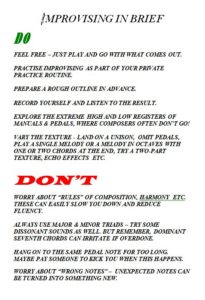A key skill for church organists
Why improvise?
In the western world two groups of musicians are often heard improvising: jazz players and church organists. How do they do it? More to the point, how do we organists do it?
Improvisation is a natural instinct in all of us, which can be both enhanced and suppressed by formal instrumental tuition. Most music around the world is improvised or memorized aurally without the aid of notation. In western and European music the reading of complex notation is essential to a performer, and this tradition has now spread all over the world. But it co-exists with the many aural traditions, and it is exciting and rewarding to be adept at both, and to be able to combine them.
A child experimenting with a musical instrument is improvising, though the fun element may be uppermost, and few outside the family would regard the result as great art. However, this tendency to make up music for fun is worth encouraging, especially if the child eventually takes formal tuition. In my view it is a mistake to suppress the improvising impulse entirely in favour of reading the dots. The tendency, certainly in the past, for music teachers at every level to discourage jazz and any other form of improvisation, has effectively blocked off that instinct for many players.
In part these videos are about having fun with music, but they are also about playing the organ during acts of worship, filling space with music when liturgical actions are going on during a service. There is often a need for music of an indeterminate length to connect one part of the service to the next: for example at the end of an introit or offertory hymn, or after the reading of the Gospel. You need to play music while looking at another part of the building, maybe via a mirror or CCTV screen, awaiting the cue to bring the music to a close.
How can a church organist gain this skill?
First of all, this is not about improvising items in a concert. There are many organists who do this regularly, indeed organists have done so for centuries, and this can both dazzle and discourage others. What follows may eventually give you the confidence to improvise whole set pieces, but this is not our initial objective. So I’m recommending a simple approach, using an individual’s existing aural knowledge of familiar music together with acquired technical skill, but without the expectation of brilliance, and certainly without the imposition of “rules”, which only inhibit musical flow.
There are, of course, books and articles aimed at developing improvisation, but these usually include printed scores to play, together with suggested chord progressions in the style of harmony exercises. My issue with these is that they replace the all-important aural approach with the inhibiting visual approach of learning from the score: the opposite of what we are aiming for. Compare this with learning to speak a language, though the analogy is not exact. The visual approach may also restrict the player to an 18th century-based “traditional harmony”. Here are three reasons for avoiding this approach:
1 If you already play hymn-tunes, your ears, fingers and feet will have already absorbed the essentials of traditional diatonic harmony, so why not use and develop that instinct without the printed score.
2 There are many styles beyond traditional diatonic harmony, so why restrict yourself. Be inspired by other styles of music which you play or listen to. Even better, experiment with your own discoveries at the keyboard.
3 Harmony is important, but set chord-progressions are not the only element in improvising; avoid the turgid, directionless series of chords which you will often hear in services. Single melody lines, open intervals in treble or bass, rhythmic gestures, isolated dissonances can all be used without reference to a rule book. Your ears, fingers and feet are your guide, but remember to give the feet an occasional rest! Or allow them to visit the top end of the pedal board for a change, maybe play a melody up there.
How to use the videos
The following short videos address different elements of improvisation. My advice would be to not rush, but to take it step by step and enjoy the process. Take each example one at a time and don’t feel you have to play them all through in one go.
You do not necessarily need to recreate exactly what is shown. Just use the basic elements as a starting point, creating what catches your imagination. Remember, in improvisation there are no set rules apart from have a go and enjoy!
Then try the next one in the same way, maybe during another session. Remember: take your time – Rome wasn’t built in a day.
Continue this process and start mixing the ideas from one example with another. Soon you will be free of any structural props and will be able to improvise at will.
Here are some notes I have used in the past for you to enlarge, look at and download by clicking on them .
Here are five exercises to start honing your skills.
1.Extending a hymn tune 2 min 30 https://youtu.be/Q51wkRh-2AM
with a simple melody and perhaps the occasional chord.
2. The Fanfare 3 min https://youtu.be/n7jmehaZBvU
3. Embellishing the Fanfare 3 min https://youtu.be/PUWvJwWnKaI4
4. The Echo 4 min https://youtu.be/svgVCsJIdRA
5. The Pentatonic Scale 4 min https://www.youtube.com/embed/YUN5l58nszk



